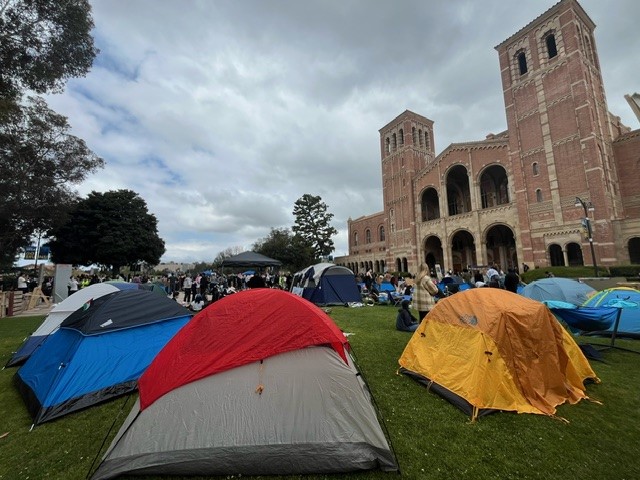LOS ANGELES -- The LA Fire Department teaches new recruits this motto: "Train like your life depends no it, because it does." A tragedy in Westchester involving the death of a firefighter last March raises the question, is firefighter training adequate?
Following is the transcript of the report:
Paul Moyer: "City firefighters mourned one of their own -- Brent Louvrien, who was killed in the line of duty last March when an electrical vault exploded on him in the west-side community of Westchester. His partner, Anthony Guzman, was seriously wounded."
Chief Franco: "There were a series of explosions that moved south on Sepulveda."
Reporter: "City officials tried to downplay the incident as ..."
Mayor Villaraigosa: "... the result of a freak accident..."
Moyer: "... caused by faulty electrical wiring.
News
Top news of the day
"But we've discovered that the cause and handling of the tragedy remain under official investigation and some experts warn the same freak accident could happen again."
Captain Armando Hogan: "As we continue to investigate, I'm not in a position here to point fingers at anyone."
Moyer: "Fire Department spokesman, Captain Armando Hogan, acknowledged in an exclusive interview that his agency is still trying to sort out what caused the accident."
Hogan: "When we determine what that is, then I'm sure we can make a better assessment as to what happened and what didn't happen."
Moyer: "But preliminary Fire Department reports, including a so-called Green Sheet, establish a basic set of facts, which show the following.
"As early as 10 a.m., March 26, 'various witnesses reported smelling odors ...' along Sepulveda Boulevard, in this section of Westchester near LAX.
"This manhole cover here blows thirty feet in the air. Workers at a nearby Staples store smell some strange odors, call 911. Fire fighters scramble.
"2:26pm: a second manhole explodes here, half a block south, in front of this building.
"On the second floor, businessman Charles Mordi hears the blast, then smells a burnt odor and spots black smoke leaking from an above-ground electrical vault here, to the rear of the building."
Mordi: "I used my cellphone and called 911 immediately."
Moyer: "More firefighters show up. Mordi hurries outside, sees Brent Louvrien try to open the vault door, then race back to his fire truck for a rotary saw."
Mordi: "As he was walking back, he told myself and one of my employees to step back."
Moyer: "Mordi moves here, a few feet away as Louvrien presses the saw to the door, his partner Tony Guzman just behind him."
Mordi: "The saw made contact with the door. You can see the spark, and that's when the explosion occurred."
Moyer: "So one question is answered: a spark from the saw triggered the final blast.
"But what was the explosive material inside the vault? And what caused the two manholes to blow?
"Most important, did the first responders do enough to insure their own safety and the public's?"
Hogan: "They took all safety precautions. They were in their protective equipment."
Moyer: "Actually, according to the Fire Department's own Green Sheet, Louvrien and two members of his own crew were wearing no protective breathing gear despite the reported presence of strange odors, and the earlier explosions."
Moyer (addressing Hogan): "Do your people on your trucks carry methane detectors?"
Hogan: "We have combustible gas indicators that we carry on our apparatus."
Moyer: "Much of Westchester is designated on this city map as a methane hazard zone, with explosive natural gases migrating from old underground oil wells. Against this backdrop, say experts, methane detectors would be a logical precaution, especially given the odors.
"But, says Hogan, detectors were not used in this instance because the first responders were too busy sizing things up."
Hogan: "It's an investigation going on, as we're trying to determine the source of the smoke. We would not have time to sit there and pull out our combustible gas indicators."
Moyer: "What does your training tell you about evacuating buildings when you arrive at a situation like Westchester that day?"
Hogan: "If there are folks who are close by and we feel like they are a possibility of being in a situation that can cause harm, we will ask them to move."
Moyer: "Hogan told us firefighters did everything necessary to insure the safety of people inside Mordi's building."
Hogan: "They immediately evacuated all of the citizens that were there."
Moyer: "But Mordi told us no one ever ordered him to evacuate. And the manager of a credit union downstairs says by e-mail that 'three members of our branch staff were inside' at the time of the explosion. Faced with such contradictions, Hogan backpedaled."
Hogan: "Our first engine company doing the investigation can only do so much ... If evacuation is needed, we'll call additional resources to cover that task."
Moyer: "As it turns out, calling for additional resources in Westchester proved extremely difficult, because, it seems, arriving firefighters were constantly talking over each other on the radio circuits, drowning out vital communications."
Moyer (addressing Hogan): "You know there were communications problems at Westchester?"
Hogan: "There are always communication challenges because of the unknown."
Moyer: "According to the Green Sheet, one unit en route to Mordi's building '... attempted to contact Light Force Five ... three times ... but received no reply.' Later, just before the fatal explosion, Louvrien's immediate superior 'attempted to give an additional size-up [a situation assessment] but this message was covered by other radio traffic.'
"Finally, there is this issue: Was it appropriate to use a spark-producing saw in an already explosive environment?
"The Fire Department's training manual warns specifically: 'When cutting metal, the saw throws off hot sparks which can provide an ignition source ... to combustible solids.'
"But Hogan says Louvrien and his captain had no way of knowing that there might be combustible matter in the vault as a result of the earlier explosions."
Hogan: "For everybody to say that it is known it is a combustible situation, that's not necessarily a fair assessment."
Moyer: "So what happened out there is not going to change the way you train with the saw?"
Hogan: "The training with the saw will not change. Maybe in this case in the future, we’ll try to be a little bit more cautious."
Moyer: "Preliminary Fire Department reports blame the explosions on burning electrical insulation and combustible vapors which, they say, traveled through underground wiring pipes to the three blast sites.
"There is no mention of methane. But a methane expert, Dr. George Chilingar of USC, told us wherever there are underground methane deposits, the gas poses a clear and present danger of repeated accidents."
Chilingar: "If methane migrates you’re going to have an explosion. And methane does migrate.
Moyer: "Several people who work near the accident site, say they smelled strange gases -- not burnt odors -- months, even days before the explosions."
Charles Chao: "It's probably a little bit before the explosion, gas smells."
Moyer: "Charles Chao, whose office is next to one of the exploding manholes, says he's detected gas odors off and on since last summer, including just before the accident, and has always suspected the source is an electrical vault downstairs."
Choa: "We smelled a little bit of the gas we smelled -- it's just like a cooking gas."
Moyer: "The Fire Department promises a final report within weeks. Meantime, witnesses express dismay that investigators haven't been in touch with them since the accident and didn't ask them very much at the time."
Mordi: "The only time -- I was interviewed twice -- one, that's the day of the incident, and then the following day. That was the last time I heard from anybody."
Moyer: "A sobering postscript: Just days after Louvrien died, workers at the Staples store there on Sepulveda smelled the same strange odors they'd detected just before the accident. Fire officials investigated and found no gases in the building. But they also never alerted the public that what killed the firefighter might still be lurking underground."



